#Salesforce API Integration
Explore tagged Tumblr posts
Text
Ready to Deploy APPSeCONNECT’s Instant SAP Business One & Salesforce Integration for Growing Businesses
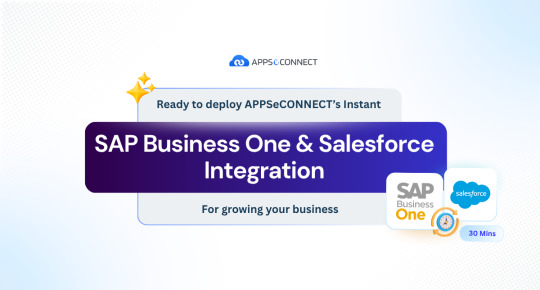
According to Gartner: Poor data quality costs organizations at least USD 12.9 million every year on average.
Growing businesses juggle SAP Business One and Salesforce integration, and following best practices ensures smooth data exchange. Without proper integration, ERP CRM data synchronization challenges cause siloed sales orders, misaligned inventories, and wasted hours on manual fixes.
A self-serve integration platform bridges these gaps instantly. Deploying a no-code, pre-built SAP Business One Salesforce integration best practices package cuts setup time to under 30 minutes, unlocks real-time data flow, and lets teams focus on growth instead of backend plumbing.
Explore how no-code integration can streamline your SAP and Salesforce systems.
The Growing Need for ERP and CRM Integration
Companies run SAP Business One for operations and Salesforce for sales insights. Yet without ERP CRM data synchronization challenges, teams juggle spreadsheets and miss updates. A unified link bridges that gap and boosts efficiency.
Understanding SAP Business One and Salesforce Integration
According to Forrester: Integration developers and data architects experienced a 35 % – 45 % productivity boost by using pre-built connectors and visual designers.
Integrating ERP and CRM means syncing orders, customer records, and inventory between SAP and Salesforce. Without it businesses hit bottlenecks—stale data, billing errors, and split workflows. Self-service ERP-CRM connectors transform this process into a no-code experience anyone can manage.
Experience how Advancing Eyecare optimized its ecommerce operations and service support with seamless integration powered by APPSeCONNECT.
No-Code Integration Platforms: Revolutionizing ERP-CRM Sync
Modern teams no longer need custom scripts or middleware. No-code integration platforms let you pick systems, map fields visually, and hit deploy—no developers required. Key benefits include:
The U.S. CRM market size was USD 22.1 billion in 2024 and is projected to reach USD 67.4 billion by 2032 (CAGR 15.1 %).
Pre-Built Connectors & Templates: Offers ready SAP Business One CRM integration blueprints for orders, contacts, and products
Drag-and-Drop Mapping: Empowers non-tech users to link fields, set filters, and schedule sync jobs in minutes
Real-Time & Batch Sync: Handles instant updates for critical data and nightly batches for bulk loads
Error Resilience: Automatically retries failed records, flags issues, and logs every step
Scalability & Elasticity: Grows with your data volume, auto-scaling under load without new hardware
For example, a mid-market distributor can use APPSeCONNECT to sync custom pricing from SAP Business One into Salesforce, cutting manual overrides by 70%.
Key Takeaway: Visual, drag-and-drop mapping lets any user deploy SAP–Salesforce sync in minutes.
The team at APPSeCONNECT was very responsive to my questions and concerns, was always happy to arrange meetings when something needed to be further discussed, and has a can-do attitude. – Matthew Clark, The Mako Group
Interested in real-world tips for ERP CRM data synchronization ? Explore our Webinars
Real-World Use Cases and Success Stories
According to McKinsey: Companies that excel at personalization generate 40 % more revenue than average players.
Businesses across sectors leverage SAP Salesforce integration use cases to drive growth:
Manufacturing: Syncs production orders into CRM, so sales reps can promise accurate delivery dates
Wholesale: Mirrors inventory levels between SAP and Salesforce to avoid oversells and backorders
Services: Pushes service tickets from Salesforce into ERP for warranty tracking and billing
Retail: Updates product catalogs automatically from SAP to e-commerce portals for consistent pricing
Healthcare: Shares patient order data securely between clinical and billing systems for faster claims
Key Takeaway: Manufacturers, retailers, and service firms see up to 70% fewer errors with pre-built SAP-Salesforce workflows.
Discover how a world-leading industrial equipment manufacturing company leveraged APPSeCONNECT for company-wide automation of ERP, CRM, and eCommerce applications.
Start a free trial to see APPSeCONNECT’s self-service integration in action
Best Practices for Implementing SAP Business One and Salesforce Integration
According to McKinsey: Two-thirds of millennials expect real-time customer service, and three-quarters of all customers want consistent cross-channel experiences.
Follow these SAP Business One Salesforce integration best practices to ensure smooth rollout:
Define Clear Data Flows: Map out which fields—like customer ID, order status, or payment terms—must sync and in what direction.
Start Small with Pilot Syncs: Test key processes (e.g., quote-to-cash in Salesforce ERP automation) before broad rollout.
Use Field-Level Filters: Sync only relevant records—such as active accounts—to reduce payload and speed jobs.
Monitor with Dashboards: Track sync health and error rates in real time to catch issues early.
Plan for Data Governance: Establish roles and permissions so only approved users can change mappings or schedules.
Key Takeaway: Defining clear data flows and running pilot syncs ensures a smooth, low-risk rollout.
Showcase managed to sync their inventory seamlessly with the help of APPSeCONNECT and provide the best-in-class products to 100+ stores across North America.
Listen to our Podcats for integration tips and industry insights
The Future of ERP and CRM Integration
The next wave of application integration tools will embed AI for predictive mapping and anomaly detection. Real-time data flow SAP Salesforce will tap machine learning to auto-resolve conflicts. Cloud adoption will push more integrations toward hybrid iPaaS models that combine edge-agent processing with centralized control.
Engage with the Integration Community
Integration thrives on shared knowledge. Tell us about your SAP Business One and Salesforce sync wins or hurdles—your story could guide others.
Salesforce Trailblazer Community: Post questions or tips in the “Integration & API” group to get expert feedback
SAP Community Network (SCN): Share how you tackled data sync in the “SAP Business One” forums and learn from peer blogs
r/integration on Reddit: Discuss real-world challenges and discover scripts or no-code patterns fellow engineers swear by
LinkedIn Integration Groups: Join “iPaaS & Integration Strategies” to swap best practices and case studies with IT leaders
Medium Publications: Follow tags like “Enterprise Integration” and “iPaaS” for deep dives and tutorials from seasoned practitioners
Your insights fuel the community’s growth. Jump into these forums, ask your burning questions, and pass on what you’ve .
Automation runs seamlessly in the background, requiring no daily intervention. Orders sync from WooCommerce to our system, while product details update effortlessly. – Dan Adler, Fulis Paperware
Explore APPSeCONNECT’s courses to get top-notch content & tips
Conclusion
SAP Business One Salesforce integration best practices demand flexibility, speed, and low maintenance. A self-service, no-code iPaaS like APPSeCONNECT meets these needs by delivering real-time, bi-directional sync, pre-built templates, and enterprise-grade security—all without developers. Businesses can eliminate manual errors, boost efficiency, and scale their ERP-CRM workflows in under 30 minutes.
FAQ
What are some issues integrating SAP Business One and Salesforce? Data silos, custom mappings, and manual upkeep often slow down sync projects.
How no-code tools simplify SAP Salesforce integration? They replace scripts with visual mapping, pre-built templates, and instant deployment.
Can you combine a canonical model with iPaaS? Yes—iPaaS can enforce a shared schema while providing flexible connectors.
Which scales better: hybrid integration or pure canonical? Hybrid iPaaS offers elastic scaling and mixed real-time/batch flows for modern needs.
How does microservices integration fit into iPaaS? You can embed services as nodes in ProcessFlow for custom logic without external code.
What is the hub-and-spoke model’s role today? It centralizes governance but may add latency; iPaaS reduces that with edge agents.
How do you measure integration scalability? Monitor throughput (transactions/sec), error rates, and resource usage under peak loads.
Why choose APPSeCONNECT for enterprise integration? Its low-code ProcessFlow Designer, pre-built templates, and enterprise-grade security meet every growth stage.
0 notes
Text
Unlock Seamless Business Operations with Salesforce Integration Services

Discover how Advent IT Solution's Salesforce Integration Services can streamline your business processes, enhance data accuracy, and improve customer insights. Whether you're a startup or an enterprise, our tailored solutions ensure smooth connectivity between Salesforce and your existing systems. Learn more about our services and how we can help your business thrive.
1 note
·
View note
Text
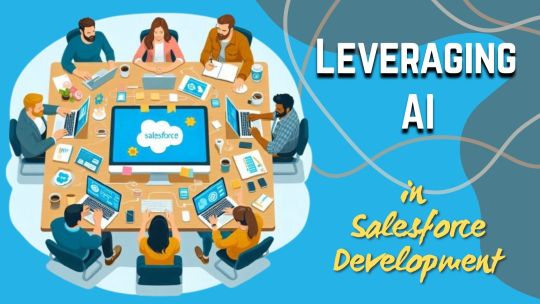
Leveraging AI in Salesforce Development
Artificial Intelligence (AI) is revolutionizing Salesforce development by infusing intelligence into traditional CRM processes. AI allows Salesforce to evolve from a static data management platform into a dynamic, insight-driven system that can predict, recommend, and automate key functions. With AI, Salesforce development is now more about building solutions that are not just reactive but proactive.
Know more at: https://www.cyberswift.com/blog/leveraging-ai-in-salesforce-development/
#generative ai in salesforce#salesforce ai cloud#salesforce einstein gpt#ai-powered crm solutions#bill cipher#salesforce automation with ai#predictive analytics in salesforce#ai-driven customer insights#ai-enhanced salesforce workflows#salesforce lightning and ai integration#chatbots and salesforce crm#salesforce consulting services#salesforce crm solutions#custom salesforce development#salesforce lightning development#salesforce app development#salesforce api integration#salesforce cloud services#salesforce automation solutions#salesforce migration services#salesforce support and maintenance#low-code salesforce development#ai-powered salesforce solutions#iot integration with salesforce#salesforce blockchain integration
1 note
·
View note
Text
By integrating Salesforce API, organizations unify customer information, enabling real-time updates and improving decision-making. This integration empowers businesses to create a centralized ecosystem where sales, marketing, and customer service teams can collaborate effortlessly. More at https://bit.ly/45xNdtn
0 notes
Text
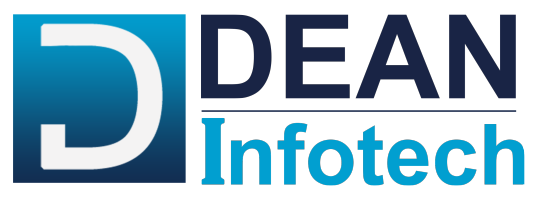
Dean Infotech GmbH
Dean Infotech GmbH ist eine in Hamburg ansässige Firma und eine Schwestergesellschaft der Dean Infotech Pvt Ltd. Indien, mit dem Fokus auf die Entwicklung von Software-Lösungen im Bereich Salesforce und Web-Technologien. Unser Ziel ist es, unsere Kunden mit dem besten aus beiden Welten zu begeistern. Zusammen, als hoch motiviertes Team, ist es unsere oberste Priorität, unseren Kunden die richtige Software, verlässlich und mit glänzendem Service anzubieten.
Address- Ballindamm 3, Hamburg, Germany - 20095 Mail- [email protected]
#Salesforce Entwicklungsunternehmen Deutschland#Salesforce Beratungsunternehmen Deutschland#Salesforce Agentur Deutschland#Salesforce Partner Agentur Deutschland#Salesforce Implementierungen Deutschland#Salesforce API Integration Deutschland#Salesforce Daten-Migration Deutschland#Salesforce CRM Deutschland#Salesforce zertifiziertes Beratungsunternehmen#Salesforce zertifizierte Agentur#Salesforce Automatisierung Deutschland#Salesforce App Entwicklung Deutschland#Salesforce Marketing Cloud Entwicklung Deutschland#Salesforce Marketing Cloud Agentur Deutschland
2 notes
·
View notes
Text
Best 7 Salesforce Marketing Cloud Integrations to Streamline SMS and Text Marketing Campaigns

Salesforce Marketing Cloud is still an effective platform to handle customer journeys at scale. Nonetheless, the text marketing Salesforce remains an area that needs careful incorporation with external applications to align the messaging workflow with data, analytics, and triggers. As customer demands evolve rapidly in and around speed and context, organizations need to move beyond a generic outreach process and create up-levelled use cases that run throughout messaging, CRM and data pipes.
This blog uncovers the seven future-proof Salesforce Marketing Cloud integrations, the responsibility of which is to design smart SMS campaigns that can grow as data-wise as you want, able to cope with dynamic marketing circumstances. Such solutions do not simply relay texts, but coordinate purposeful communication with the use of complete intelligence of your CRM.
1.360 SMS App Native Multi Channel Messaging within Salesforce
The 360 SMS App is one of the most versatile SMS apps in Salesforce that allows Marketing Cloud users to implement logic-based workflows of texting in Salesforce without code. Instead of using only scheduled sends, marketers can set SMS journeys that are triggered by field updates or record changes or even custom events. Having 11+ channels supported, including WhatsApp, Viber, and Instagram messaging, 360 SMS will enable teams to go further than email and embrace direct-response platforms. It is also possible to make Salesforce data that is referenced deeply within the middle of the campaign, and this is as well as dynamic personalization without list export.
2. Twilio in Marketing Cloud- Custom Messaging through Marketing Cloud SMS API
Marketing Cloud SMS API can be used to connect the plumbing of Twilio programmable messaging with Salesforce Marketing Cloud. Although this has higher developer interaction than that of native solutions, it gives flexibility to support custom use cases, particularly within the context of multinationals or a highly regulated setting. In combination with Journey Builder, the configuration may channel transactional notices, post-acquisition communications, and subscription processes through programmable logic developed external to Salesforce.
3. Marketing Cloud- MobileConnect Native SMS Marketing Infrastructure
The most common text marketing beginning in Salesforce is Salesforce-provided MobileConnect in Marketing Cloud. It supports simple SMS, stimulated alerts and short codes. However, because it has a close native integration, MobileConnect is best used when supplemented by APIs or other outside expansions. Teams operating MobileConnect in a decoupled capacity with some apps, such as 360 SMS or WhatsApp Business Platform, frequently realize additional freedom in sectionation and design choices in interaction.
4. WhatsApp Business Platform Integration
To the brands interested in engaging in a conversation interface, adding WhatsApp Business to the Marketing Cloud creates new opportunities. This method can be designed in a most effective way, typically as authorized message templates and combined with pre-sales, delivery, or appointment processes.
5. Zapier + Salesforce Marketing Cloud- No-Code External Text Triggering
Zapier offers a native substitute for low-code alternatives to native Marketing Cloud integrations. Combined with SMS APIs such as Twilio, ClickSend, or MessageMedia, it is possible to initiate SMS sends via external actions (e.g. off a form, payment event, or spreadsheet update). Although Zapier is not made specifically to work with Marketing Cloud, it can be used as a middleware layer that allows it to connect to non-Salesforce systems and make them work together with campaign logic. It is a path commonly researched by the teams which want to avoid custom development to send SMS events-based.
6. Slack + Salesforce Marketing Cloud -In-house Alerts through SMS Duplicating
Even though closer internal communications are Slack's bread and butter, 360 SMS works especially well in combination with Salesforce to provide timely responses on high-value conversations, customer support requests, or even message delivery failures or customer responses.
7. Marketing Cloud Journeys Upcoming (Custom Webhooks)Real-time triggers of external SMS systems
Marketing Cloud Journey Builder enables webhooks, thus allowing the invocation of SMS APIs in real time. Such an approach is common in the case where region-specific carriers are involved, or environments where compliance is paramount and forms most of the effort in sending messages via approved aggregators. Although such an approach necessitates technical implementation, it allows brands to manage all aspects of the text, including timestamp, processing of message format, etc., according to CRM information or behavioural incidents.
Constructing a Dynamic SMS plan with Marketing Cloud
All these integrations have a particular role in the perfection of the use of SMS in marketing based on Salesforce. Being able to launch campaigns straight out of Journey Builder, tracking lead form completions on social sites, and being able to override drip text flows across time zones make messaging no longer one-way, but responsive.
The actual power of such tools is in the way they interact with CRM data structures. An example is the 360 SMS application, which will enable field-level logic to dictate message frequency, timing and languages, and respect the opt-in status and compliance rules. It is not a matter of sending a message but creating a rule-based system that would interpret your audience data every time a decision is made.
The success of SMS and text-based campaigns in Salesforce does not involve the number of messages, but rather it involves a calculated action based on each message sent. Based on the appropriate integrations, the marketers will be able to capture their Salesforce Marketing Cloud strategy to near-real-time customer intelligence, as opposed to inflexible scheduling.
Teams that want sophisticated Salesforce messages functionality can rely on the 360 SMS App to provide the extensive native connection and enterprise-level customizability. The free capacity to connect to the appropriate media with ensuring security and flexibility, is going to be the next generation of CRM-centered marketing as the rules and regulations relating to messaging, behavior of the customer and formats of the campaigns change.
1 note
·
View note
Text

🚀 Seamless Connectivity with Codinix – Your Trusted API Integration Partner!
Looking for reliable API integration service providers to streamline your business operations? Codinix ensures secure, scalable, and efficient API solutions that connect your apps, automate workflows, and enhance data exchange.
✅ Seamless Third-Party Integrations ✅ Real-Time Data Synchronization ✅ Scalable & Secure API Solutions
Let’s build a connected future! 🌍💡 Partner with Codinix today.
Call: ☎️ +1 (771) 333-2222 | +91 (881) 485-2222 Email:✉️ [email protected] Visit Us: 🌐 https://codinix.com/api-integrations
#salesforce#clouds#consultants#api integration#techsolutions#businessautomation#seamlessconnectivity#DigitalTransformation#softwaredevelopment#cloudsolutions#salesforce marketing cloud consultants
0 notes
Text
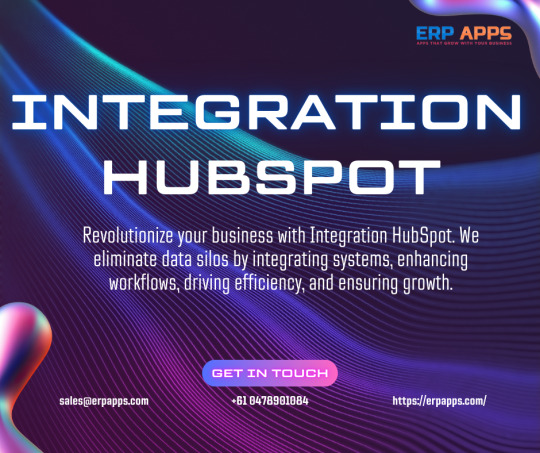
Revolutionize your business with Integration HubSpot. We eliminate data silos by integrating systems, enhancing workflows, driving efficiency, and ensuring growth.
Visit Us! https://erpapps.com/hubspot-integration/
#Integration hubspot#salesforce hubspot integration#best hubspot integrations#hubspot api integration#hubspot sms360 integration
0 notes
Text
🔗 Seamlessly Connect Your Systems with Salesforce Integration Services! 🌐
Struggling to sync your Salesforce CRM with other tools and platforms? Salesforce Integration Services ensure that all your business systems—from ERP to marketing automation—work together seamlessly! Streamline your operations, boost data accuracy, and unlock new efficiencies. Dextara Datamatics
✅ Effortless Data Sync ✅ Enhanced Workflow Automation ✅ Custom API Integrations ✅ Real-Time Insights Across Platforms
Integrate smarter and accelerate your business success! 🚀💼
#salesforce consultant#salesforce consulting services#boost data accuracy#and unlock new efficiencies.#✅ Effortless Data Sync#✅ Enhanced Workflow Automation#✅ Custom API Integrations#✅ Real-Time Insights Across Platforms#Integrate smarter and accelerate your business success! 🚀💼#Salesforce#DigitalTransformation#BusinessEfficiency#CRM#DataSync
0 notes
Text
#whatsapp business api#Salesforce and WhatsApp Integration#WhatsApp Business Solution#whatsapp business#WhatsApp Chatbots
1 note
·
View note
Text
0 notes
Text
Maximizing Efficiency with Salesforce Integration Tools and Managing API Limits
Salesforce is a powerhouse in the world of customer relationship management (CRM). However, to truly harness its potential, understanding and leveraging Salesforce integration tools while managing API limits is crucial. But how do you integrate Salesforce seamlessly with other tools, and how can you avoid hitting those pesky API limits? Let's explore these questions.

Understanding Salesforce Integration Tools
Salesforce integration tools are designed to bridge the gap between Salesforce and other systems, ensuring data flows seamlessly and processes are streamlined. These tools can range from native Salesforce applications to third-party software solutions.
Types of Integration Tools
Native Tools: Salesforce offers several built-in tools like Salesforce Connect, Data Loader, and MuleSoft. These are optimized for Salesforce and provide robust integration capabilities.
Third-Party Tools: Solutions like Zapier, Boomi, and Jitterbit offer versatile integration options that can connect Salesforce to a wide array of other systems.
Custom Integrations: Sometimes, bespoke integration solutions are necessary. These are usually developed using Salesforce's robust API and custom code.
Key Benefits of Using Integration Tools
Streamlined Operations
Integration tools automate the transfer of data between Salesforce and other systems, reducing manual data entry and minimizing errors. This leads to more efficient operations and better data accuracy.
Improved Data Insights
With seamless data integration, businesses can get a holistic view of their operations. For instance, integrating Salesforce with an ERP system can provide comprehensive insights into both customer relationships and financial performance.
Enhanced Customer Experience
By integrating Salesforce with other customer-facing systems, businesses can ensure that customer data is up-to-date across all platforms. This leads to more personalized interactions and a better overall customer experience.
Managing Salesforce API Limits
API limits in Salesforce are in place to ensure fair usage and to protect the performance of the platform. Understanding these limits and how to manage them is essential for maintaining smooth operations.
What are Salesforce API Limits?
Salesforce imposes limits on the number of API calls that can be made within a 24-hour period. These limits vary based on the type of Salesforce edition and the number of user licenses.
Strategies to Manage API Limits
Optimize API Usage
Batch Processing: Combine multiple operations into a single API call. This is particularly useful for data updates, where bulk operations can be grouped together.
Efficient Data Retrieval: Use queries that return only the data you need. Avoid unnecessary fields and filters to minimize API usage.
Monitor API Usage
Usage Reports: Salesforce provides built-in tools to monitor API usage. Regularly reviewing these reports helps identify patterns and areas for optimization.
Alerts and Notifications: Set up alerts to notify administrators when API usage approaches critical thresholds. This proactive approach can prevent disruptions.
Use Caching and Other Techniques
Data Caching: Implement caching strategies to reduce the frequency of API calls for frequently accessed data.
Asynchronous Processing: Where possible, use asynchronous methods to spread out API calls and reduce peak usage.
Best Practices for Salesforce Integration
To ensure successful Salesforce integration, it's important to follow best practices that align with your business needs and technical capabilities.
Plan Thoroughly
Before implementing any integration, have a clear understanding of your requirements. Map out data flows, define objectives, and identify potential challenges.
Choose the Right Tools
Select integration tools that align with your business needs and technical environment. Consider factors such as scalability, ease of use, and support.
Test Extensively
Before going live, thoroughly test the integration. This should include testing for data accuracy, performance, and error handling.
Maintain Documentation
Keep comprehensive documentation of your integration processes. This will be invaluable for troubleshooting and for training new team members.
Conclusion
Integrating Salesforce with other tools and managing API limits can significantly enhance your business operations. By leveraging the right integration tools, optimizing API usage, and following best practices, you can ensure that your Salesforce implementation delivers maximum value.
Do you find yourself struggling with Salesforce API limits or unsure of which integration tools to choose? Reach out to our team of experts at NlineAxis for personalized guidance and support. Transform your Salesforce experience and unlock its full potential today!
By understanding and applying these strategies, you can overcome the challenges of Salesforce integration and API management, leading to a more efficient, data-driven, and customer-centric organization.
0 notes
Text
Salesforce CRM implementation involves careful planning, strategic execution, and continual optimization to achieve successful uptake and utilization throughout your organization.
#salesforce#salesforce development services#salesforce development company#appexchange services#salesforce automation company#salesforce certified consultants#appexchange company#salesforce automation services#development#salesforce development agency#salesforcecodex#salesforce api integration company#salesforce api integration services#salesforce consulting company#salesforce partner company#salesforce consulting services#salesforce crm company#salesforce implementation company#salesforce implementation services
1 note
·
View note
Text
A Guide to Salesforce Integration Methods: APIs, Low-Code & No-Code
In today's interconnected digital landscape, the ability to seamlessly integrate various systems is crucial for businesses aiming to streamline their operations and enhance productivity. Salesforce, a leading customer relationship management (CRM) platform, offers a plethora of integration methods to connect with other applications and systems. From traditional APIs to low-code and no-code solutions, Salesforce provides options tailored to the diverse needs and technical expertise of businesses. Let's delve into these integration methods to understand their functionalities and benefits.
Application Programming Interfaces (APIs): APIs serve as the backbone of modern software integration, enabling different applications to communicate and share data efficiently. Salesforce offers robust APIs, including REST and SOAP, allowing developers to build custom integrations tailored to their specific requirements. RESTful APIs are widely preferred for their simplicity and flexibility, enabling seamless data exchange between Salesforce and external systems over HTTP. On the other hand, SOAP APIs provide a more structured approach with standardized messaging protocols, suitable for complex integrations requiring stringent security measures.
API-based integrations offer unparalleled flexibility and customization, empowering businesses to orchestrate complex workflows, synchronize data in real-time, and automate processes across multiple platforms. However, building and maintaining API integrations typically require a certain level of technical expertise, making them ideal for organizations with dedicated development teams or access to skilled developers.
Low-Code Integration: Recognizing the growing demand for rapid application development and integration, Salesforce introduced low-code platforms like Salesforce Lightning Flow and Salesforce AppExchange. These platforms leverage visual, drag-and-drop interfaces, enabling business users and citizen developers to create custom integrations without extensive coding knowledge.
Salesforce Lightning Flow, for instance, empowers users to design automated workflows and integrate Salesforce with third-party applications using a graphical interface. With pre-built connectors and templates, users can quickly configure integration scenarios, such as lead-to-cash processes or customer support ticket management, without writing complex code.
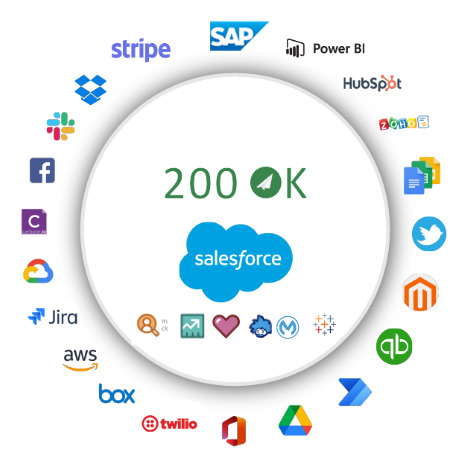
Check out 200 OK for versatile integration solutions. Efficiently connect Salesforce with other tools like SAP, Dynamics, Workday, Quickbooks, Stripe, PowerBI, and more without requiring any infrastructure, ensuring smooth workflows and optimized operations.
Low-code integration platforms offer a balance between flexibility and simplicity, enabling organizations to accelerate integration projects, reduce dependency on IT resources, and drive innovation across departments. Moreover, these platforms foster collaboration between business users and IT teams, facilitating the rapid deployment of integrated solutions tailored to evolving business needs.
No-Code Integration: For businesses seeking an even more accessible integration solution, Salesforce provides no-code tools like Salesforce Connect and MuleSoft Composer. These platforms eliminate the need for any manual coding, allowing users to establish seamless connections between Salesforce and external data sources through intuitive configuration interfaces.
Salesforce Connect enables real-time integration with external data sources, such as ERP systems or legacy databases, without data replication. By creating external objects mapped to data sources, users can access and manipulate external data within Salesforce seamlessly. Similarly, MuleSoft Composer simplifies integration by offering pre-built connectors and workflows for common integration scenarios, such as synchronizing contacts or orders between Salesforce and other applications.
No-code integration solutions democratize the integration process, enabling business users with limited technical skills to connect Salesforce with external systems and unlock valuable insights from disparate data sources. By democratizing integration, organizations can foster innovation, improve data accessibility, and drive digital transformation initiatives across the enterprise.
In conclusion, Salesforce offers a diverse range of integration methods, catering to the varying needs and technical proficiencies of businesses. Whether through APIs, low-code platforms, or no-code tools, organizations can seamlessly connect Salesforce with other applications and systems, enabling streamlined processes, enhanced collaboration, and accelerated innovation in today's digital ecosystem.
0 notes
Text
Custom API Integration Services
#Custom API Integration Services#integration#api integration services#custom api integration services#salesforce integration#custom api integration#uipath integration service#custom module integration#third party api integration services#crm integration#custom hosted web services#integration service connection builder#salesforce integration tutorial#servicenow rest integration#rest integration servicenow#third-party api integration#servicenow integration using rest
1 note
·
View note